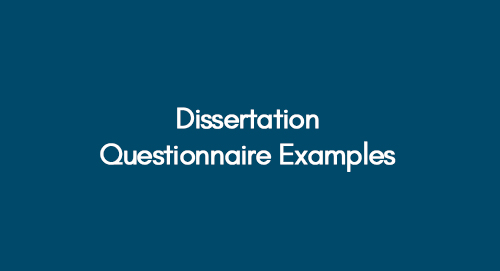
What is PhD Thesis Writing? | Beginner’s Guide
November 23, 2022
130+ Interesting Oil Field Safety Topics with Research Aims
November 23, 2022A questionnaire stands as one of the essential tools in a researcher's toolkit. When skillfully crafted, a thoroughly organized questionnaire can provide priceless insights that shape and elevate the course of your dissertation. This piece will present guidance on formulating a survey that produces substantial and meaningful results.
Why Do You Need a Questionnaire?
If you're currently completing your dissertation, you're likely at the questionnaire phase. This is a crucial stage of your research as it helps you gather data and insights from your participants.
Learn More About Data Analysis Processes Here
One way to ensure you're gathering valuable and accurate data is by using dissertation questionnaire examples. These examples can guide crafting your own questionnaire, ensuring that you're asking the right questions and collecting the necessary data.
Learn More About Research Questions
The following section will provide you with a comprehensive questionnaire example extracted from a dissertation for your study.
Data Collection Method
The data collection method was primary as the study collected data directly from 60 employees in global financial institutes, in line with the research aim. Following Saunders (2011: 119) on positivism, a quantitative approach was used, employing a closed-ended questionnaire to gather data from the participants.
Learn the Difference Between Qualitative and Quantitative Approaches
The following section will analyse the questions writing process by dissection an old questionnaire:
The questionnaire was created after reviewing prior literature, with questions targeting professionals in global financial institutes regarding Bitcoin's potential as a currency or investment. It featured dichotomous questions where respondents chose between yes or no (Bryman & Bell, 2011). This closed-ended survey was shared online via social media links. A pilot study assessed the questionnaire's validity, involving 6 respondents, as recommended (Field, 2013). After confirming validity, the same questionnaire was used for the full study with 60 respondents (Creswell, 2009).
Q1: Gender
| Frequency | Percent | |
| Male | 30 | 50.0 |
| Female | 30 | 50.0 |
| Total | 60 | 100.0 |
The second question was asked to select the financial institution (sector) where the respondents worked to know how many respondents were from banks, brokerage houses, and insurance companies.
Q 2: Please Select Your Financial Institution (Sector).
| Frequency | Percent | |
| Banking | 26 | 43.3 |
| Brokerage | 28 | 46.7 |
| Insurance | 6 | 10.0 |
| Others | 0 | 0 |
| Total | 60 | 100.0 |
The third question was comprised of the analysis of how many respondents have ever encountered Bitcoin transactions. As analyzed earlier the overall respondents were from financial institutions and were more focused on the transactions of Bitcoins.
Q 3: Have You Ever Encountered a Bitcoin Transaction?
| Frequency | Percent | |
| Yes | 44 | 73.3 |
| No | 16 | 26.7 |
| Total | 60 | 100.0 |
Based on the responses to the fourth question, it was analyzed whether an ordinary man can understand the processing mechanism of Bitcoins.
Q 4: Do You Agree that the Bitcoin processing Mechanism is So Complex that an Ordinary Person cannot Understand it?
| Frequency | Percent | |
| Yes | 41 | 68.3 |
| No | 19 | 31.7 |
| Total | 60 | 100.0 |
The next question comprised of the analysis that after one or two decades is there any possibility that the majority of the people around the world regard Bitcoins as a normal currency?
Q 5: Do You Think that Most People Around the World Will Be Ready to Use Bitcoins as a Currency After 10 to 20 Years?
| Frequency | Percent | |
| Yes | 18 | 30.0 |
| No | 42 | 70.0 |
| Total | 60 | 100.0 |
In the sixth question regulation of Bitcoins was questioned to know if as per the respondents' Bitcoins could be used as a currency without getting regulated.
Q 6: It is Possible that Bitcoins could be Used as a Currency without Getting Regulated?
| Frequency | Percent | |
| Yes | 3 | 5.0 |
| No | 57 | 95.0 |
| Total | 60 | 100.0 |
This dissertation questionnaire example is extracted from a premier dissertation project.
What is a Dissertation Questionnaire?
A dissertation questionnaire is a research tool utilized to collect data from a large group of people. It is usually given to students as part of their dissertation research process. The questionnaire comprises a series of questions about the respondent's opinions, experiences, or knowledge on a particular topic.
Explore Stellar Questionnaire Examples Here
Usually, dissertation questionnaires are administered online, though paper copies can also be distributed. While dissertation questionnaires can vary in length and format, all questionnaires should include some common features, such as clear instructions, an introduction to the research topic, and well-constructed questions.
Dissertation questionnaires are an important part of many research projects. They can help gather data from a large group of people quickly and efficiently. When creating a dissertation questionnaire, it is important to keep the following things in mind:
The questionnaire should be clear and concise.
The questions should be well-constructed and easy to understand.
The instructions must be clear and easy to follow.
The introduction should provide context for the research project.
Essential Questions to Ask in Your Dissertation Questionnaire
- What is the purpose of your research?
- What are your research objectives?
- What research questions do you hope to answer with your study?
- What is your research hypothesis or main thesis?
- What methods will you utilize to collect data?
- Who is your target population or sample group?
- How will you ensure that your data is reliable and valid?
- What ethical considerations are there in your research design?
Resources on Questionnaire Design And Analysis
- Questionnaire Design
- Sampling
- Data Collection
- Data Analysis
- Reporting
- Quality Control
- Ethics
- Resources
Dissertation Questionnaire Examples for Master’s Students
- What motivates you to pursue a master’s degree?
- Why did you choose your current field of study?
- What are your long-term career aspirations?
- How will a master’s degree help you to achieve your goals?
- What research experience do you have?
- What are your research interests?
- Why did you choose your current supervisor/advisor?
- What are the most important skills for success in your field of study?
Tips to Compose an Engaging Questionnaire for Your Dissertation
Define Your Goals
It's necessary to spend some time considering your objectives before you begin creating your questionnaire. What type of data are you trying to gather? You'll be able to create questions that are more likely to yield the appropriate outcomes after you clearly understand your objectives.
Keep it Short and Sweet
Getting your participants to take the time to complete your questionnaire can be a challenge on its own. Therefore, when creating your questionnaire, remember that simplicity is key. Keep your questions concise and focused, and restrict the overall number of questions to a maximum of 20.
Ask Mostly Closed-Ended Questions
Answers to closed-ended questions can be as straightforward as "yes" or "no," or they can include selecting from a predetermined list of options. On the other hand, open-ended questions require respondents to write their answers in their own words. Closed-ended questions are generally preferred as they are much easier to analyze quantitatively.
Avoid Loaded Questions
Loaded questions are those that are leading or biased in nature. For example, a question such as “Don’t you think students should be required to take a foreign language in high school?” is loaded because it assumes that the respondent already agrees with the premise of the question. Loaded questions should be avoided as they can lead to unreliable and invalid results.
Make Sure Your Questions are Unambiguous
Your questionnaire should be easy for respondents to understand; otherwise, you risk misinterpretation and inaccurate results. Be sure to proofread your questionnaire thoroughly before administering it to ensure no typos or grammatical errors.
Also, use clear and concise language throughout – avoid jargon or technical terms that respondents may not be familiar with.
Use Simple Language
Use simple, straightforward language in your questions. Avoid technical jargon or abbreviations that respondents might not understand. Be clear and concise in your wording so that respondents can easily answer the question.
How to Survey Your Marketing Dissertation?
Define Your Research Question
The first step in conducting a survey is to define your research question. That will help determine the type of survey you need to conduct and the information you hope to collect.
Choose Your Target Population
The next step is to choose your target population. It is the group of people you will be surveying. It is important to choose a target population representative of the larger population you are interested in.
Select a Sampling Method
Once you have chosen your target population, you will need to select a sampling method. This is the method you will use to select the individuals who will participate in your survey. There are several different sampling methods, so choosing one that is appropriate for your study is important.
Develop Your Questionnaire
After you have selected your sampling method, you will need to develop your questionnaire. This is the list of questions that you will ask your participants. It is important to ensure that your questions are clear, concise, and relevant to your research question.
Pretest Your Questionnaire
Before administering your questionnaire, it is important to pretest it with a small group of people similar to your target population. It will help ensure that your questions are clear and yield the information you hope to collect.
Administer Your Survey
Once you have pretested your questionnaire, you can begin administering your survey. This can be done in person, by mail, or online. It is important to ensure that all your participants have an equal opportunity to respond to your questionnaire.
Analyze Your Results
After you have collected all of the responses to your questionnaire, it is time to analyze them. It involves looking at the data and determining its meaning concerning your research question.
Write up Your Findings
Once you have analyzed your results, you will need to write up your findings in a report or paper. This should include an interpretation of what the data means in relation to your research question
Conclusion
Following these simple tips will help you design a questionnaire that is more likely to elicit useful information from respondents. Keep your questions short and focused, avoid loaded questions, and make sure your questions are clear and unambiguous. By taking the time to design a well-constructed questionnaire, you will be one step closer to ensuring the success of your dissertation project. You may Contact Premier Dissertations to develop a questionnaire section that helps you collect accurate data.
More on dissertation section writing below.
Get 3+ Free Custom Examples & Topics within 24 hours;
Get an Immediate Response
Discuss your custom requirements with our writers
Free Online Plagiarism Checker For Students
We will email you the report within 24 hours.
Upload your file for free plagiarism





























